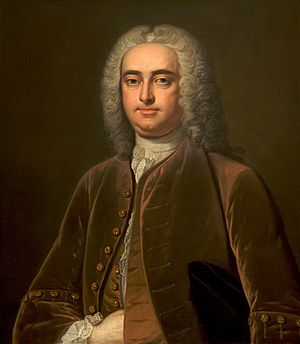Thomas Winnington (1696–1746) facts for kids

Thomas Winnington was an important English politician who lived from 1696 to 1746. He was a member of the Whig party and served in the British Parliament for many years. He came from Stanford Court in Worcestershire.
Contents
Who Was Thomas Winnington?
Thomas Winnington was born on December 31, 1696. He was the second son of Salwey Winnington, who was also a Member of Parliament (MP) for Bewdley. His mother was Anne Foley. Thomas's grandfather, Sir Francis Winnington, had been a top lawyer called the Solicitor General in the 1670s.
Early Life and Education
Thomas went to Westminster School, a famous school in London. After that, he studied at Christ Church, Oxford university in 1713. He also joined the Middle Temple in 1714, which is a place where people train to become lawyers.
His Political Career
Thomas Winnington first became a Member of Parliament (MP) in 1726, representing Droitwich. Even though he started as a Tory, he quickly became a Whig and supported the government. He was re-elected without opposition in 1727 and 1734.
In 1741, he was elected for both Droitwich and Worcester. Worcester was a more important area, so he chose to represent Worcester in Parliament.
Thomas was a strong supporter of the Prime Minister, Robert Walpole. Because of his support, he was given several important jobs:
- In 1730, he became a Lord of the Admiralty, helping to manage the navy.
- From 1736 to 1742, he served as a Lord of the Treasury, dealing with government money.
- In 1741, he joined the Privy Counsellor, a group of important advisors to the King. He also became the Cofferer of the Household, managing the King's household expenses.
When Henry Pelham became Prime Minister in 1743, he appointed Thomas Winnington as Paymaster General of the Forces. This was a very important job, as he was in charge of paying the army. He held this position for the last two and a half years of his life.
Thomas Winnington also bought parts of his family's estate at Stanford. His grandfather had first acquired this property. He also bought the rights to the manor of Bewdley.
Family and Home
In 1719, Thomas Winnington married Love Reade. She was the daughter of Sir James Reade from Brocket Hall in Hertfordshire. Thomas and Love did not have any children.
After Thomas passed away, the Stanford Court estate went to his cousin, who later became Sir Edward Winnington. The original Stanford Court mansion, which was very old, unfortunately burned down on December 5, 1882. Many valuable books and old papers in the library were destroyed.
Stanford Court was rebuilt after the fire. It remained the family home until it was sold by Sir Francis Winnington, the 6th Baronet, in 1949.
Images for kids


